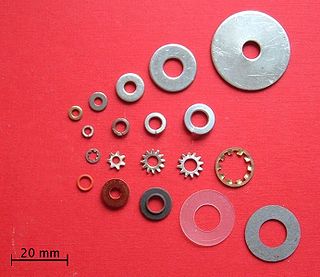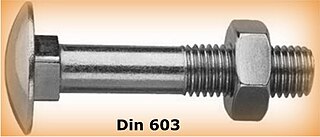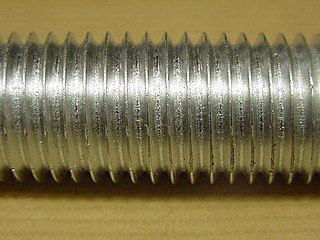Fasteners with a tapered shank
| American name | British name | Description | |
|---|---|---|---|
| | chipboard screw particle board screw | Similar to a drywall screw, except that it has a thinner shank and provides better resistance to pull-out in particle board, while offset against a lower shear strength. The threads on particle board screws are asymmetrical. | |
| concrete screw Tapcons masonry screw Confast screw multi-material screw blue screw self-tapping masonry screw Titen | A stainless or carbon steel screw for fastening wood, metal, or other materials to concrete or masonry. Concrete screws are commonly blue in color, with or without corrosion coating. They may either have a Phillips flat head or a slotted hex washer head. Nominal (thread) sizes range from 0.1875 to 0.375 in (4.763 to 9.525 mm) and lengths from 1.25 to 5 in (32 to 127 mm). Typically an installer uses a hammer drill to make a pilot hole for each concrete screw and a powered impact driver to drive the screw. The drill hole should be 1/2" longer than the depth penetration of the screw. The screw itself should be drilled a minimum of 1" into the concrete to hold effectively and a maximum of 1-3/4" or the threads will wear and will lose holding power. Ideally 1-1/4" to 1-1/2" of screw thread in the concrete. [1] So for example, if a 1/2" board is being screwed onto the concrete, a 1-3/4" to 2" concrete screw should be used. | ||
| deck screw | Similar to drywall screw, except that it has improved corrosion resistance and is generally supplied in a larger gauge. Most deck screws have a type-17 (auger type) thread-cutting tip for installation into decking materials. They have bugle heads that allows the screw to depress the wood surface without breaking it. | ||
| | double-ended screw dowel screw hanger bolt | handrail bolt | Similar to a wood screw but with two pointed ends and no head, used for making hidden joints between two pieces of wood. A hanger bolt has wood screw threads on one end and machine threads on the other. A hanger bolt is used when it is necessary to fasten a metal part to a wood surface. |
| drive screw hammer drive screw | Chiefly used for attaching manufacturers data plates to equipment. Smooth round or mushroom headed with a multi-start thread on the shank, beneath which is reduced diameter shank that acts as a pilot. The screw is fastened by hitting the head with a hammer and is not intended for removal. [2] | ||
 | drywall screw | Specialized screw with a bugle head that is designed to attach drywall to wood or metal studs, but it is a versatile construction fastener with many uses. The diameter of drywall screw threads is larger than the grip diameter. | |
 | eye screw screw eye vine eye loopheaded screw | screw eye | Screw with a looped head. Larger ones are sometimes called lag eye screws. Designed to be used as attachment point, particularly for something that is hung from it. A vine eye (in the UK at least) is similar to a screw eye, except that it has a proportionally longer shank and smaller looped head. As the term suggests vine eyes are often used for attaching wire lines across the surface of buildings so that climbing plants can attach themselves. |
 | lag bolt lag screw [3] | coach screw | Similar to a wood screw, except that it is generally much larger running to lengths up to 15 in (381 mm) with diameters from 0.25–0.5 in (6.35–12.70 mm) in commonly available (hardware store) sizes (not counting larger mining and civil engineering lags and lag bolts) and it generally has a hexagonal drive head. Lag bolts are designed for securely fastening heavy timbers (post-and-beam, timber railway trestle bridges) to one another, or to fasten wood to masonry or concrete. The German standard is DIN 571, Hexagon head wood screws. Lag bolts are usually used with an expanding insert called a lag in masonry or concrete walls, the lag manufactured with a hard metal jacket that bites into the sides of the drilled hole, and the inner metal in the lag being a softer alloy of lead, or zinc alloyed with soft iron. The coarse thread of a lag bolt and lag mesh deform slightly, making a secure, near watertight, anti-corroding, mechanically strong fastening. |
 | mirror screw | This is a flat-head wood screw with a tapped hole in the head, which receives a screw-in chrome-plated cover. It is usually used to mount a mirror. | |
 | sheet metal screw | Has sharp threads that cut into a material such as sheet metal, plastic or wood. They are sometimes notched at the tip to aid in chip removal during thread cutting. The shank is usually threaded up to the head. Sheet metal screws make excellent fasteners for attaching metal hardware to wood because the fully threaded shank provides good retention in wood. | |
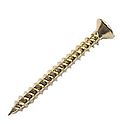 | Twinfast screw | A Twinfast screw is a type of screw with two threads (i.e. a twin-start screw), so that it can be driven twice as fast as a normal (i.e. single-start) screw with the same pitch. [4] Drywall screws designated as fine are the most common screws to use the twinfast style of threads. [5] | |
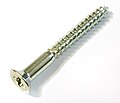 | wood screw | A metal screw with a sharp point designed to attach two pieces of wood together. Wood screws are commonly available with flat, pan, or oval-heads. A wood screw generally has a partially unthreaded shank below the head. The unthreaded portion of the shank is designed to slide through the top board (closest to the screw head) so that it can be pulled tight to the board to which it is being attached. Inch-sized wood screws in the U.S. are defined by ANSI-B18.6.1-1981(R2003), while in Germany they are defined by DIN 95 (Slotted raised countersunk (oval) head wood screws), DIN 96 (Slotted round head wood screws), and DIN 97 (Slotted countersunk (flat) head wood screws). | |
 | Security head screw | These screws are used for security purposes and where vandalism and/or theft is likely. The head of this type of screw is impossible to reverse. It requires special tools or mechanisms like spanners, tri-wings, torxes, square drivers, etc. In some screws, the head can be removed by breaking it after installing the screw. |














